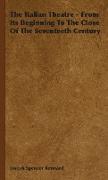- Start
- The Italian Theatre - From Its Beginning to the Close of the Seventeeth Century
The Italian Theatre - From Its Beginning to the Close of the Seventeeth Century
Angebote / Angebote:
THE ITALIAN THEATRE- FROM ITS BEGINNING TO THE CLOSE OF THE SEVENTEENTH CENTURY by JOSEPH SPENCER. Originally published in 1931. FOREWORD: A HISTORY of the Italian Theatre should mean more than a study of important Italian plays. It should reflect the successive phases of the Italian social conscience, and through the succeeding centuries of the national evolution, depict the changing life of the Italian people. Such a theatre presumes to photograph life, not omitting its crudities and cruelties. It will also interpret the national character, and portray the historical background. It is also the theatre of psychology, presenting the struggle between the flesh and the spirit, the losing and win ning of Mansoul. It is also the teatro di poesia, wherein reality is transformed by the poet into drama. More even than all this its stage is the world, since the church, the civilization, the liter ature of Western Europe, of which the theatre is a part, are all of Italian origin. To compass adequately, within a few hundred printed pages, a subject so vast, so varied, is impossible. For the privilege of saying a little, the author has been obliged to omit much, to com press more, and sometimes, perhaps, to appear dogmatic and superficial. To my wife, for her constant help and encouragement, to the Printing House of William Edwin Rudge for this distinguished example of the printer s art, and their unfailing courtesy and to those others who have been helpful, I am grateful. . s. K. Ne w Tork November, 1931. Contents include: CHAPTER I PAGE 3 THE ORIGIN OF THE ITALIAN THEATRE, CLASSICAL AND CHRISTIAN The pagan Roman theatre as one of the sources of the Italian theatre, a comparison of the Greek and Roman theatre with reference to the benefits and liabilities result ing from the imitation of Greek art Native Latin drama the satura, satire, and atellanai Latin poets important for their influence upon the Italian theatre Plautus, Terence, and Seneca Antagonism of the early Christian Church to the corrupt Augustan theatre Rise of pantomimic art, Chirosofi and Panfoni, cantico and fantoccio Satirization of the Church by the mimes Their persistence past the tenth century The writings of Hrosvita. The Christian Church as the second and more important source of the Italian theatre Elaboration of Church ritual Gradual dramatization of the Roman liturgy Evolution of the liturgical drama Consolidation of episodes, apocryphal insertions of characters and narratives Growing complexity of scenery with consequent shift from ecclesiastical locale Change to the vernacular Reasons for the Church s policy in enriching the ritual suggested Typical sacred drama. CHAPTER II PAGE 21 THE CHRISTIAN CHURCH AND THE MEDIAEVAL THEATRE The relation of the drama to contemporary Italian life Early history of the Roman Catholic Church Ascendancy of Church over State Conflict between Empire and Papacy Penance of Henry IV Distinction between the early Christian Church of the Apostles and Romanized Church The lattcr s influence upon all intellectual and artistic activities The Church s organization of the theatre. Additional sources of the Christian Drama the laud Cult of the disciplinati and Flagellants and their lauds Classification of the laud Its evolution into dramatic form the Devotioni-. Cyclical Drama Connection of the laud with religious text and liturgy Spread of the Dcvotioni. The Sacra Rappresentazione...
Folgt in ca. 15 Arbeitstagen

